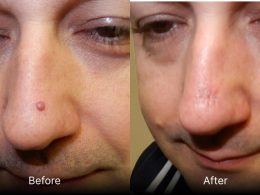There’s more information about eczema in babies on the internet than anybody could absorb in a lifetime, so we’ve distilled our knowledge into eight easy steps that will help you get through the first few months of your baby’s eczema.
Don’t be alarmed: seeing an angry, crimson rash spread across your baby’s cheeks and forehead is terrible. However, you’re not alone; eczema is quite common. At some point in their life, over 20% of youngsters will have it.
Eczema generally appears between the third and fourth months of life, although most children outgrow it by the age of two.
Ditch the soaps and toiletries – natural oils and an acid mantle protect the skin, but soaps and toiletries are degreasing and alkaline. Even ‘gentle’ baby toiletries harm your baby’s skin by removing its protective oils and neutralizing the acid mantle.
Use only water in your baby’s bath and avoid using baby wipes. Plain water is usually sufficient. If you need additional, use an emollient (medical moisturizer) to wash the skin.
If you’re washing your clothes, use half the amount of detergent (you won’t notice a difference), perform an extra rinse cycle, and avoid detergents and stain removers that include optical brighteners or fragrance.
Keep your baby’s skin as intact as possible. Eczema is a highly itchy condition that can even scratch before a rash appears. Itching leads to scratching, which results in scabs and infections, making the itch worse and detergents often cause this.
To avoid scaring, keep your baby’s nails short and use hypoallergenic toddler gloves at night. Most importantly, don’t use steroid creams until your baby is at least two months old. Steroids can be useful in extreme cases (and they’re the only way to stop the itch), but you must not overuse them.
Prevention is better than cure – breastfeed exclusively for six months. If possible, avoid using formula milk before your baby is six months old; if you need to, switch between breastfeeding and formula starting at four months of age without skipping feeds.
Avoid any unnecessary medications (such as antibiotics) during breastfeeding unless necessary. Don’t apply fragranced cream or lotions on your new-born’s skin.
Start solids after six months but introduce new foods one by one so that you can identify potential allergies.
If your baby’s skin is bad, it doesn’t mean he has an allergy. If you’ve tried these methods and they haven’t helped, consult a doctor. Your paediatrician will probably recommend steroid creams or antihistamines, but they can become addictive so try to avoid them if possible.
The good news is that eczema usually goes away on its own by the time your child reaches two years old. The following are some precautions you can take to help prevent eczema in your kid:
Another child (the more siblings you have, the less risk) – Breastfeeding for at least 6 months helped to prevent eczema.
Immediately after bathing, morning and before going to bed, use emollients (medical moisturizers). You can never have too many! You may also use them between baths or sessions. Afterwards, be sure to let the emollient “soak” into the skin completely before putting on clothing.
If your baby’s hands are severely inflamed by eczema, you might be able to avoid irritating her skin even further by switching to a sodium lauryl sulfate-free dish soap
It’s awful to watch an enraged crimson rash spread over your baby’s cheeks and forehead. However, eczema is a typical problem.
Get an appointment with your doctor to discuss eczema treatment. Emollients, which are the key component of any eczema therapy and are available on prescription, should be used. Your doctor will be able to advise you on which emollients would work best for your child and how to use them effectively.
Your doctor may prescribe topical steroids to relieve the itching in your baby’s eczema if it is severe enough to affect their sleep. Steroid creams are safe as long as you follow your doctor’s instructions, but they should only be used to manage flare-ups and not for long-term eczema treatment.
Consult with your family. Although eczema and eczema triggers are sometimes hereditary, it usually goes away quickly, so you may not realize that you or a sibling have been afflicted. I didn’t know I had eczema as a baby (or when I was a teenager) until my son developed eczema and my mother suddenly became an expert source of information.
Make sure that dairy protein allergy (CPMA) isn’t an issue. CMPA affects about 7% of infants, most of them being bottle-fed. It usually goes away by the time they start school.
Symptoms can appear right after eating or might take hours, days, or even weeks to develop, including upset stomach (reflux, colic, diarrhoea), irritable skin (redness or swelling around the eyes and mouth), hay-fever-like symptoms (runny nose and wheezing), and eczema that does not respond to therapy.
Your doctor will be able to give special formula milk if your baby is diagnosed with CPMA. Do not offer your infant any other kind of milk unless you get medical advice first.
Be persistent. There is no single cure for eczema, and each person’s case is different. It may take time to locate emollients that are suitable for your baby, as well as time for skin to heal and the acid mantle to be restored.
Why not check out ScratchSleeves as a solution. They’re like a cardigan with a silky outer layer, they can be worn over or beneath clothes. They are easy to put on, but virtually impossible for babies and toddlers to remove by themselves.









